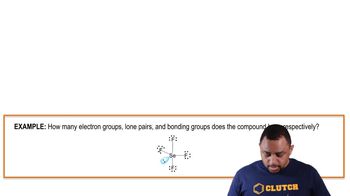Determine the electron geometry, molecular geometry, and idealized bond angles for each molecule. In which cases do you expect deviations from the idealized bond angle?
a. CS2
b. SCl2
c. CHF3
d. PF3
 Tro 6th Edition
Tro 6th Edition Ch.11 - Chemical Bonding II: Molecular Shapes, VSEPR & MO Theory
Ch.11 - Chemical Bonding II: Molecular Shapes, VSEPR & MO Theory Problem 39c
Problem 39c Verified step by step guidance
Verified step by step guidance



Determine the electron geometry, molecular geometry, and idealized bond angles for each molecule. In which cases do you expect deviations from the idealized bond angle?
a. CS2
b. SCl2
c. CHF3
d. PF3
Which species has the smaller bond angle, H3O+ or H2O? Explain.
Which species has the smaller bond angle, ClO4- or ClO3- ? Explain.
Determine the molecular geometry and sketch each molecule or ion using the bond conventions shown in “Representing Molecular Geometries on Paper” in Section 11.4. d. BrF5
Determine the molecular geometry and sketch each molecule or ion, using the bond conventions shown in “Representing Molecular Geometries on Paper” in Section 11.4. b. SCl4
Determine the molecular geometry and sketch each molecule or ion, using the bond conventions shown in “Representing Molecular Geometries on Paper” in Section 11.4. c. ClF3